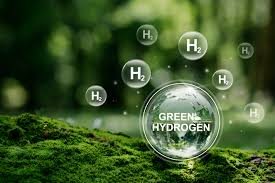Why in the news?
Recently the Ministry of New and Renewable Energy has introduced a pioneering scheme to advance green hydrogen adoption through pilot projects.
Green Hydrogen
Hydrogen is an abundant, cheap and clean-burning which is described as the fuel of the future.
It is produced using electrolysis of water with electricity generated by renewable energy.
The carbon intensity ultimately depends on the carbon neutrality of the source of electricity (i.e., the more renewable energy there is in the electricity fuel mix, the “greener” the hydrogen produced).
Advantages of green hydrogen
Reduction of emissions-
Green hydrogen, produced from renewable energy sources, offers a clean alternative to traditional fossil fuels it will significantly reduce harmful emissions such as carbon dioxide and particulate matter.
Curbing pollution-
The adoption of hydrogen fuel in transportation can play a crucial role in curbing pollution in Indian cities, which are grappling with severe air quality issues.
Meet climate goals-
India has committed to ambitious climate targets under the Paris Agreement and Panchamrit was adopted by India at COP-26.
Panchamrit
By 2030, India will Reach its non-fossil energy capacity of 500 GW
Meet 50% of its energy requirements from renewable energy
Reduce the total projected carbon emissions by 1 billion tonnes
Reduce the carbon intensity of its economy by less than 45%
By 2070, India will achieve the target of Net Zero Emission.
Reducing fossil fuel imports-
By developing a domestic it’s industry, India can reduce its dependence on costly fossil fuel imports, enhance energy security, and diversify its energy sources, bolstering its resilience to supply disruptions and price fluctuations in the global energy market.
Business opportunity-
The transition to green hydrogen presents a significant business opportunity for India, both domestically and internationally. emerging hydrogen economy, attracting investment, creating jobs, and driving economic growth in key sectors such as manufacturing, energy, and transportation.
Zero carbon emission-
Hydrogen Fuel Cell Vehicles utilize hydrogen through combustion (similar to diesel and petrol cars) but emit no carbon
Energy efficiency-
The Hydrogen Fuel Cell Electric Vehicles convert hydrogen stored in a high-pressure tank into electricity via electrochemical reactions, research indicates that burning hydrogen in ICE vehicles is less energy-efficient than using it in fuel cells.
Steps taken by India to promote green hydrogen
Scheme for green hydrogen in transportation-
It validate technical feasibility and performance of green hydrogen as a transportation fuel.
Pilot projects for mobility-
It will assess the practicality of green hydrogen as a fuel in buses, trucks and four wheelers that will help bridge the viability gap arising from the relatively higher capital costs associated with hydrogen powered vehicles.
National green hydrogen mission-
It aims to position India as a global hub for green hydrogen production, usage and export, this would make India self-reliant in clean energy and inspire a global transition towards cleaner energy sources.
SIGHT-
Strategic Interventions for Green Hydrogen Transition includes financial incentive mechanisms for manufacturing electrolysers, green hydrogen production to promote it’s adoption.
Green hydrogen hubs-
It will identify and develop regions capable of supporting large-scale green hydrogen production and utilization which will serve as green hydrogen hubs.
Enabling policy framework-
The mission will waive interstate transmission charges for renewable energy in green energy production, facilitate renewable energy banking and time bound grant of open access and connectivity to facilitate green hydrogen production.
India’s 1st Green Hydrogen plant in stainless steel sector is recently inaugurated in Haryana, it will be the world’s 1st off-grid Green Hydrogen plant for the stainless-steel industry and the world’s 1st Green Hydrogen plant with rooftop and floating solar.
Challenges in green hydrogen
High cost of green hydrogen-
The high cost of producing green hydrogen, primarily due to the energy-intensive electrolysis process, remains a major barrier.
Logistical challenges for green hydrogen –
It requires specialized infrastructure for storage and transportation, which adds to the overall cost and complexity of the hydrogen supply chain.
Infrastructure deficit for green hydrogen-
The high cost of infrastructure deployment and limited consumer demand pose significant challenges.
Market dynamics of green hydrogen-
It currently faces stiff competition from conventional fuels and battery electric vehicles (BEVs), particularly in terms of fuel costs and infrastructure availability.
Storage concerns for green hydrogen-
The lack of suitable storage solutions for high-pressure hydrogen cylinders presents a significant technical barrier.
Safety concerns for green hydrogen-
Hydrogen’s flammability requires stringent safety standards and protocols for handling and storage, especially at refuelling stations.
Stiff competition-
Advances in battery technology and the decreasing cost of electric vehicle batteries pose a long-term challenge to the viability of hydrogen fuel cell vehicles, particularly in the heavy-duty commercial vehicle sector.
More to Read
- National Green Hydrogen Mission
- The Hindu | Centre clears ₹19,744 cr. Green Hydrogen Mission
- CAR-T Cell Therapy – India’s First Home-Grown Gene Therapy for Cancer




